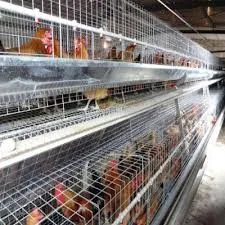Innovative Poultry Cage Designs for Efficient H-Type Farming Systems
Dec . 30, 2024 03:01 Back to list
Innovative Poultry Cage Designs for Efficient H-Type Farming Systems
The Advantages of H-Type Poultry Cages
The poultry industry has witnessed remarkable advancements over the years in terms of production efficiency, welfare of animals, and overall management practices. Among the notable innovations that have emerged is the H-type poultry cage system. This innovative design has not only revolutionized how poultry farming is conducted but has also provided significant benefits in terms of space utilization, hygiene, and bird welfare.
What is an H-Type Poultry Cage?
H-type poultry cages are specifically designed to accommodate layers and broiler chickens. Characterized by their unique H-shaped structure, these cages maximize vertical space while minimizing the footprint of the entire setup. The design features multiple tiers of cages stacked vertically, allowing farmers to house more birds in a given area. This is particularly beneficial for those looking to optimize limited space in poultry farms.
Space Efficiency
One of the standout advantages of the H-type cage design is its efficient use of space. In traditional farming methods, birds require larger areas to roam and nest, which can significantly increase overhead costs due to land and resource requirements. H-type cages condense these operations, allowing poultry farmers to maintain the same number of hens while using a smaller footprint. This can lead to reduced land rental costs and improved overall profitability per square meter.
Improved Hygiene and Biosecurity
Hygiene is paramount in poultry farming to ensure the health and productivity of the birds. The H-type cage system is designed to enhance biosecurity measures, keeping diseases at bay. The stacked cage system allows for better air circulation and easier access for cleaning. Farmers can systematically clean and manage each tier without disturbing the others, reducing the risk of cross-contamination. Moreover, the design allows for better drainage and waste management, which is crucial in maintaining a clean environment for the poultry.
h type poultry cage

Enhanced Bird Welfare
Animal welfare is an increasingly important topic in the poultry industry, and the H-type cage system makes strides in this area. Although traditional cage systems have faced criticism regarding space and bird comfort, modern H-type cages provide individual nesting areas, perches, and space for the birds to move within their designated area. Furthermore, the design reduces stress on the birds as it minimizes overcrowding and provides easier access to food and water.
Ease of Management
Managing a poultry operation can be labor-intensive, but the H-type cages simplify many aspects of farm management. The vertical layout allows farmers to monitor the birds easily and conduct health checks without excessive effort. Automated feeding and watering systems can be integrated seamlessly into the design, further streamlining daily operations. This efficiency not only saves time but also reduces labor costs, allowing farmers to focus on other critical aspects of their business.
Economic Benefits
Investing in H-type poultry cages may require initial capital expenditure, but the long-term economic benefits are undeniable. With increased space efficiency, improved hygiene, and better management practices, farmers can expect higher productivity levels. This translates into a more consistent supply of eggs or meat, higher-quality produce, and ultimately, increased profit margins. Additionally, with rising consumer demand for ethically raised poultry, having an advanced system like the H-type may improve marketability and customer trust.
Conclusion
The H-type poultry cage system represents a significant step forward in poultry farming practices, balancing the needs for efficiency and animal welfare. By maximizing space, ensuring superior hygiene, and enhancing overall management, it promises to support farmers in meeting growing demands sustainably. As the poultry industry continues to evolve, the H-type cage stands as a testament to innovation that prioritizes both productivity and the well-being of the birds it houses. Investing in such systems could very well be the key to future success in poultry farming.
-
Hot Sale 24 & 18 Door Rabbit Cages - Premium Breeding Solutions
NewsJul.25,2025
-
Automatic Feeding Line System Pan Feeder Nipple Drinker - Anping County Yize Metal Products Co., Ltd.
NewsJul.21,2025
-
Automatic Feeding Line System Pan Feeder Nipple Drinker - Anping County Yize Metal Products Co., Ltd.
NewsJul.21,2025
-
Automatic Feeding Line System - Anping Yize | Precision & Nipple
NewsJul.21,2025
-
Automatic Feeding Line System - Anping Yize | Precision & Nipple
NewsJul.21,2025
-
Automatic Feeding Line System-Anping County Yize Metal Products Co., Ltd.|Efficient Feed Distribution&Customized Animal Farming Solutions
NewsJul.21,2025






